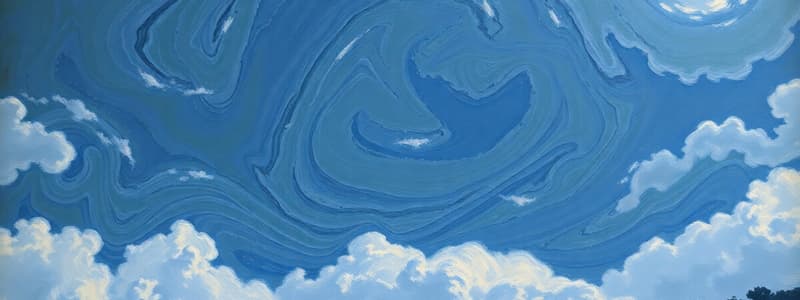Podcast
Questions and Answers
Which of the following is not a direct result of the Earth's rotation on wind patterns?
Which of the following is not a direct result of the Earth's rotation on wind patterns?
- Coriolis Effect deflects winds to the left in the Southern Hemisphere
- Coriolis Effect deflects winds to the right in the Northern Hemisphere
- Two convection cells break into six convection cells
- Winds blow from areas of high pressure to areas of low pressure (correct)
Which of the following describes the effect of the Coriolis Effect on wind in the Southern Hemisphere?
Which of the following describes the effect of the Coriolis Effect on wind in the Southern Hemisphere?
- Winds are deflected to the left. (correct)
- Winds are accelerated by the Coriolis Effect.
- Winds are deflected to the right.
- Winds are unaffected by the Coriolis Effect.
What would happen to wind patterns if the Earth did NOT rotate?
What would happen to wind patterns if the Earth did NOT rotate?
- Wind patterns would be simpler, with only two convection cells. (correct)
- Wind patterns would be significantly more complex.
- Wind patterns would be more chaotic and unpredictable.
- Wind patterns would be unaffected.
What is the primary cause of wind?
What is the primary cause of wind?
Which of the following is a direct consequence of the Coriolis Effect?
Which of the following is a direct consequence of the Coriolis Effect?
How do cyclones and anticyclones differ?
How do cyclones and anticyclones differ?
What is the largest desert in the world?
What is the largest desert in the world?
Which of the following is a feature of the jet stream?
Which of the following is a feature of the jet stream?
Which of the following is TRUE about hurricanes in the Northern Hemisphere?
Which of the following is TRUE about hurricanes in the Northern Hemisphere?
What is the approximate latitude of temperate rainforests?
What is the approximate latitude of temperate rainforests?
What is the purpose of the Hurricane Tracking Lab?
What is the purpose of the Hurricane Tracking Lab?
What is responsible for the westward movement of hurricanes below 30 degrees North latitude?
What is responsible for the westward movement of hurricanes below 30 degrees North latitude?
What happened to Hurricane Sandy that caused it to move westward instead of northeast?
What happened to Hurricane Sandy that caused it to move westward instead of northeast?
Flashcards
Coriolis Effect
Coriolis Effect
The deflection of winds caused by Earth's rotation, shifting right in the Northern Hemisphere and left in the Southern Hemisphere.
Convection Cells
Convection Cells
Circulating patterns of wind due to differences in temperature and pressure, leading to energy distribution in the atmosphere.
Northern Hemisphere Wind Direction
Northern Hemisphere Wind Direction
In the Northern Hemisphere, wind is deflected to the right due to the Coriolis Effect.
Southern Hemisphere Wind Direction
Southern Hemisphere Wind Direction
Signup and view all the flashcards
Number of Convection Cells
Number of Convection Cells
Signup and view all the flashcards
Cyclones
Cyclones
Signup and view all the flashcards
Anticyclones
Anticyclones
Signup and view all the flashcards
Global wind patterns
Global wind patterns
Signup and view all the flashcards
Hurricane movement below 30 N
Hurricane movement below 30 N
Signup and view all the flashcards
Hurricane movement above 30 N
Hurricane movement above 30 N
Signup and view all the flashcards
Jet stream
Jet stream
Signup and view all the flashcards
Sandy's path change
Sandy's path change
Signup and view all the flashcards
Largest desert
Largest desert
Signup and view all the flashcards
Study Notes
Global Wind Patterns
- Global wind patterns are driven by the uneven heating of Earth's surface
- Differences in the angle of insolation at different latitudes cause locations in the tropics to receive more energy than polar regions
- The atmosphere acts as a heat transfer system, moving warm air towards higher latitudes and cool air toward the equator
- On a hypothetical non-rotating planet, two large thermal cells would form
- The Coriolis effect, caused by the Earth's rotation, breaks these cells into six convection cells
- Trade winds are located near the subtropical highs and blow consistently from an easterly direction
- Westerlies are dominant west-to-east winds in regions poleward of the subtropical highs
- Polar easterlies are winds blowing from the polar high toward the subpolar low
- Polar fronts are stormy zones separating cold polar air masses from warmer tropical air masses
- Jet streams are fast-moving air currents in the upper atmosphere
- Jet streams are located between 10-15 km above Earth's surface
- The position of the jet stream is strongly influenced by the temperature gradient between air masses
- Storms in the United States generally move towards the northeast based on global wind patterns
- Hurricane paths are influenced by global winds, with hurricanes below 30 degrees North moving west. Above 30 degrees North, they move northeast
- Jet streams can affect hurricane paths, sometimes pulling storms back towards the west.
- Winter jet streams move faster, farther south, and are more curved than summer jet streams.
Cyclones and Anticyclones
- Cyclones have low pressure at the center
- Cyclones have warm, less dense air rising
- Cyclones have convergent surface winds coming together
- Cyclones have counterclockwise airflow in the Northern Hemisphere, clockwise in the Southern Hemisphere
- Anticyclones have high pressure at the center
- Anticyclones have cold, dense air sinking
- Anticyclones have divergent surface winds moving apart
- Anticyclones have clockwise airflow in the Northern Hemisphere, counterclockwise in the Southern Hemisphere
- Convergence means air coming together
- Divergence means air going apart
Studying That Suits You
Use AI to generate personalized quizzes and flashcards to suit your learning preferences.




